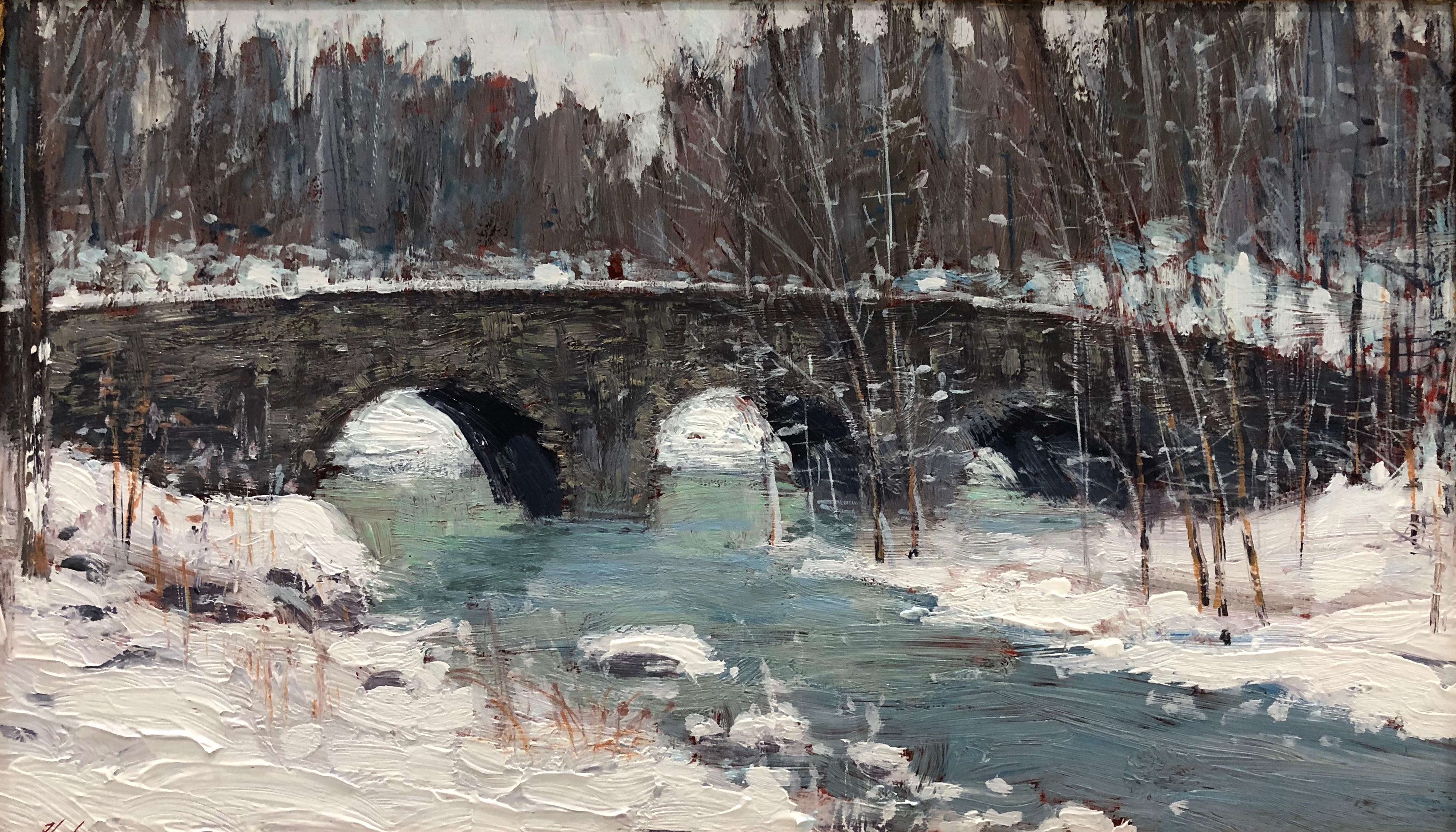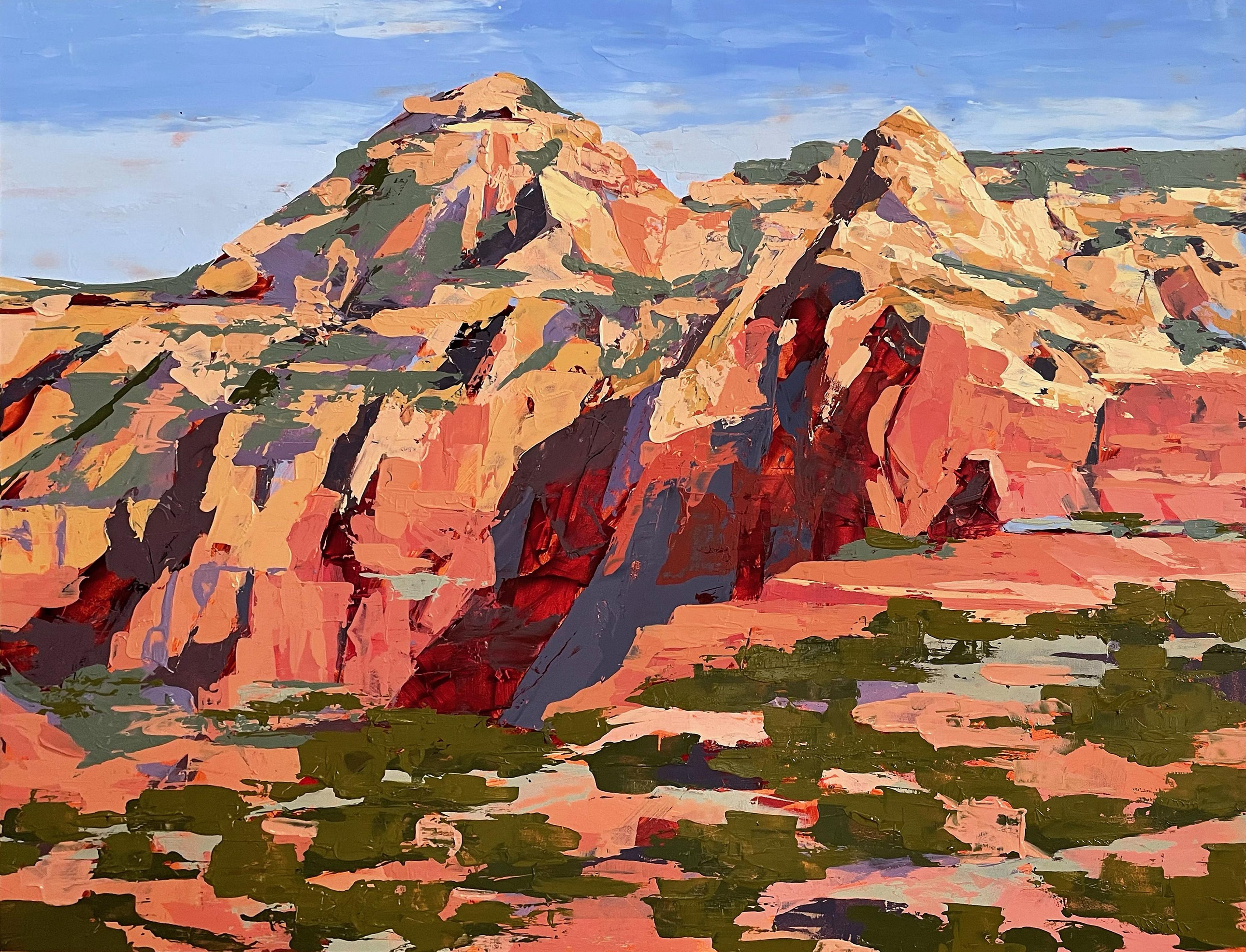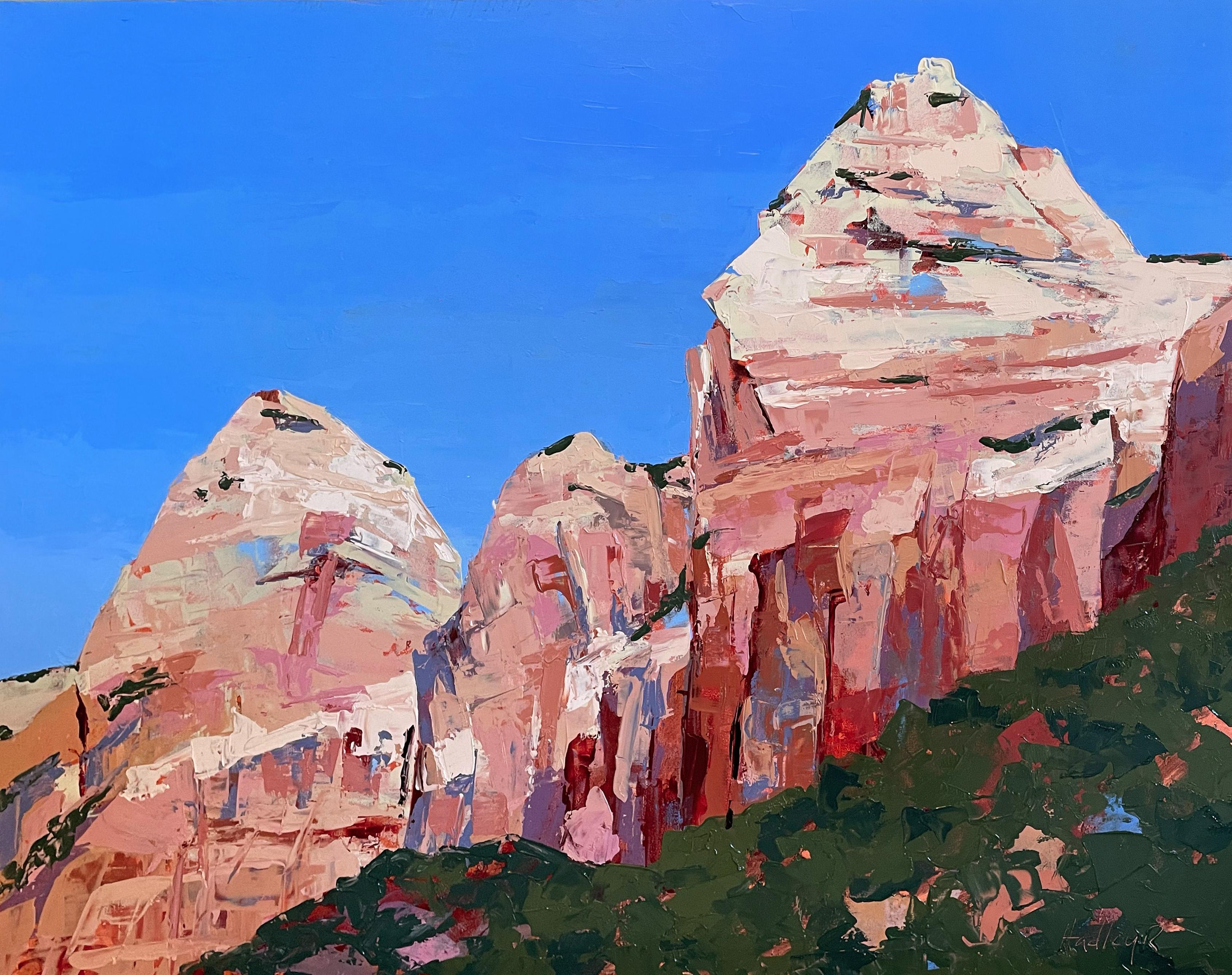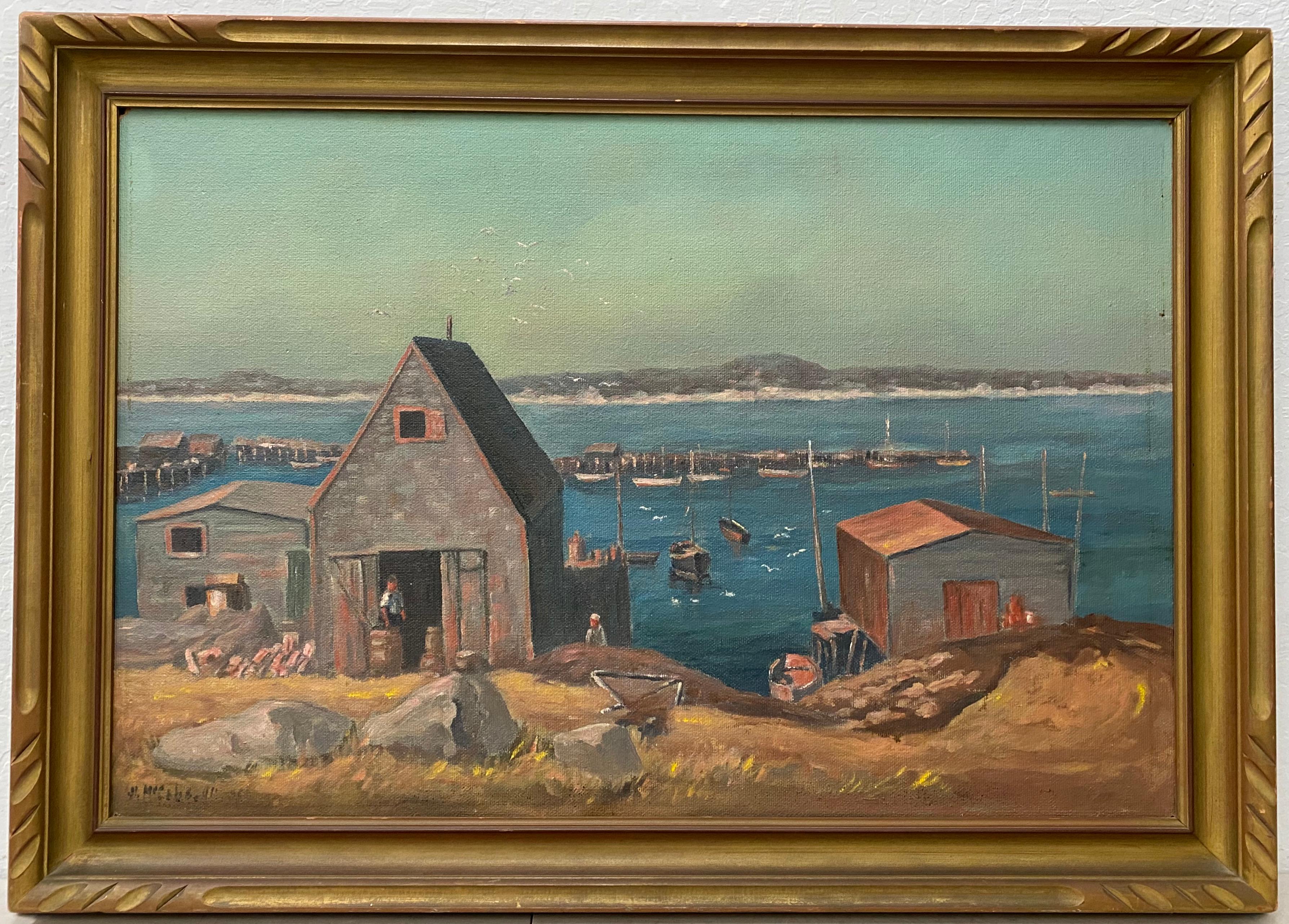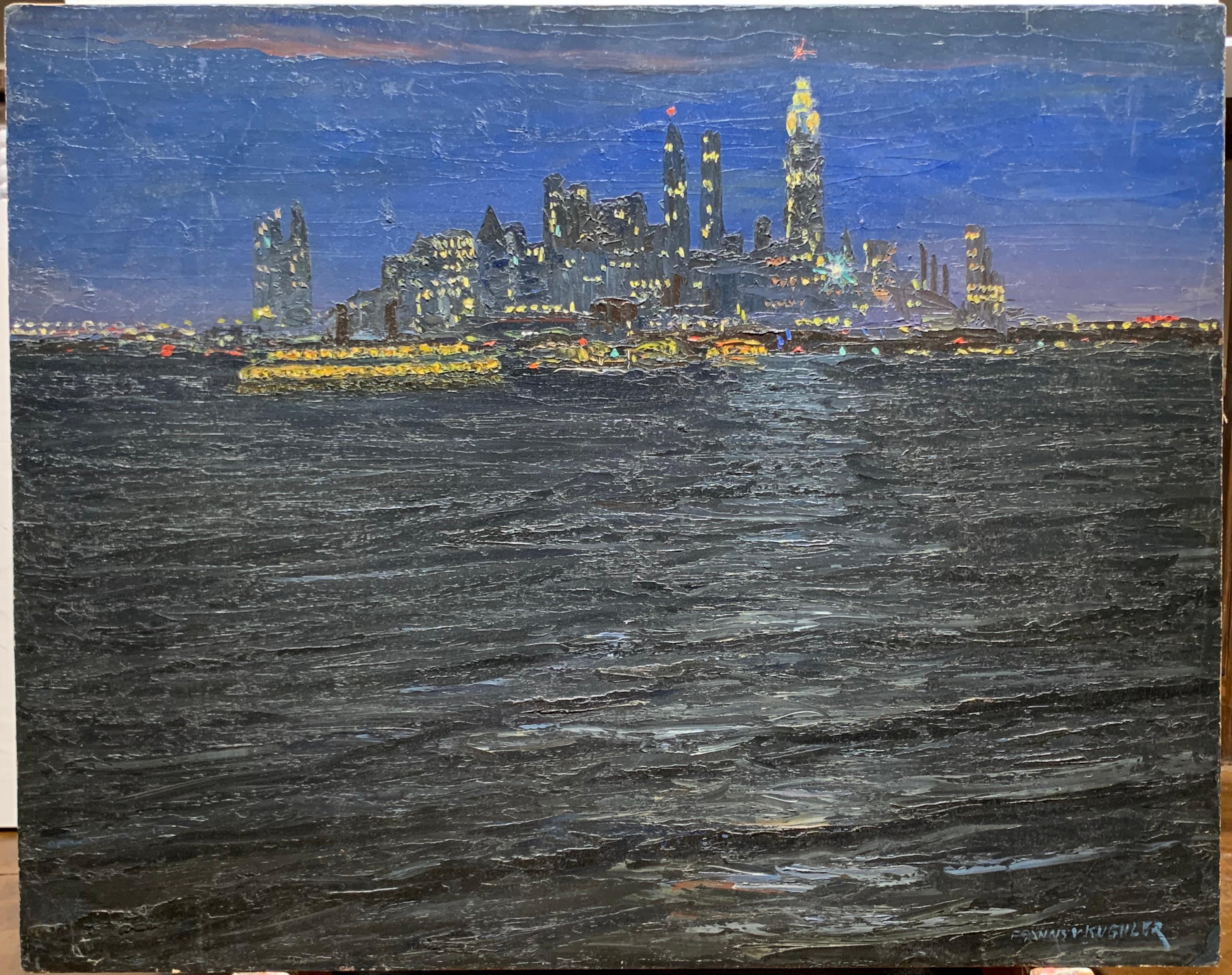Items Similar to "FLINT HILLS" 49 x 57 FRAME ORIGINALLY FROM HIS DAUGHTER'S COLLECTION
Want more images or videos?
Request additional images or videos from the seller
1 of 19
Birger Sandzen"FLINT HILLS" 49 x 57 FRAME ORIGINALLY FROM HIS DAUGHTER'S COLLECTIONCIRCA 1940
CIRCA 1940
About the Item
Birger Sandzen
(1871-1954)
Kansas / Colorado Artist
Image Size: 40.5 x 48
Frame Size: 49.5 x 57 Hand carved gold leaf frame.
Medium: Oil
"The Flint Hills"
Has his daughter's name on the verso.
This painting was donated to Bethany college by Birger's Daughter. The college owned it for many years and then about 8 years ago it was sent to auction. It sold to an art dealer from Santa Fe, it was acquired from a gallery by a friend of mine who has owned it since that time.
Biography
Birger Sandzen (1871-1954)
Born Blidsberg, Sweden, Feb. 5, 1871; died Lindsborg, June 19, 1954.
Painter, specialized in landscapes. Etcher. Engraver. Lithographer.
Teacher. Attended the College and Academy of Skara as a pupil of Olof
Erlandsson.
After graduation from Skara College, Sandzén spent a semester at Lund
University attending art history lectures and continuing the study of
French. Following Lund University he went to the technical high
school at Stockholm, where he studied perspective and form drawing.
Sandzén joined a group of young artists and they rented a studio at
Anders Zorn's suggestion. They received instruction from Zorn as well
as Richard Bergh, a well-known portrait painter and Per Hasselberg, one
of Sweden's best sculptors.
Sandzén then went to Paris to study with Aman Jean, where he began to
associate with American students in the French studies. On
returning home in 1894, a family friend sent Sandzén a booklet about
Bethany College, Lindsborg and the town called "Little Sweden."
Sandzén moved to Lindsborg in 1894 to teach French, voice, art history,
drawing and painting at Bethany College where he remained on the
faculty until 1946.
He first painted in the Colorado Springs, CO area in 1916, and became a
frequent visitor to Santa Fe and Taos, NM beginning in 1918.
Sandzén spent the summers of 1923-24 teaching at the Broadmoor Academy
in Colorado Springs (presently the Colorado Springs Fine Arts
Center). Sandzén also taught at Chappell House (the forerunner to
the Denver Art Museum), Utah State Agricultural College, Stephens
College, the University of Michigan, and the 188 Kansas City Art
Institute.
Sandzén's style of painting is unusual in its thick and heavy
application of impasto in bold and bright color combinations,
interpreting the landscape of the western United States. He is
known for very colorful renderings of mountain lakes with boulders,
cypress and aspen trees and moonrises along waterways.
Sandzén was an important advocate for art in the region, spending time
talking to people about art, organizing exhibitions and establishing
art clubs. He donated artwork to the local art club to help raise money
for the purchasing of art books for the library, the financing of
exhibitions, and the occasional awarding of a scholarship.
He painted murals for the Halstead Post Office, Where Kit Carson Camped, in 1941, for the Lindsborg Post Office, Smoky River, in 1938, and for the Belleville Post Office, Kansas Stream, in 1939. He illustrated three books, With Brush and Pencil (1905), In the Mountains, (1925), The Smoky Valley, (1922).
SOURCES:
Susan Craig, "Biographical Dictionary of Kansas Artists (active before 1945)"
Lindquist, Emory Kempton. Birger Sandzén: An Illustrated Biography. (Lawrence University Press of Kansas, 1993); American Magazine of Art, (Jan. 1927); International Studio ( Apr. 1923); Kansas Teacher (Nov. 1927); Greenough, Charles P. The Graphic Work of Birger Sandzén. (Lindsborg : Bethany College, 1952); Fielding, Mantle. Mantle Fielding’s Dictionary of American Painters, Sculptors and Engravers, with an Addendum containing Corrections and Additional Material on the Original Entries. Compiled by James F. Carr. New York: James F. Carr Publ., 1965.; Newlin, Gertrude Dix (Development of Art in Kansas. Typed Manuscript, 1951); Sain, Lydia. Kansas Artists, compiled by Lydia Sain from 1932 to 1948. Typed Manuscript, 1948.; WW26-27; American Art Annual. New York: American Federation of Arts, 1898-194727; Who’s Who in American Art. New York: American Federation of Arts, 1936- v.1=1936-37 v.3= 1941-42 v.2=1938-39 v.4=1940-47. 1, 2, 3, 4; Reinbach, Edna, comp. “Kansas Art and Artists”, in Collections of the Kansas State Historical Society. v. 17, 1928. p. 571-585.; A &C KS por il.; Dunbier, Paul. The Dunbier Value Guide; Over 1200 Painters in the Western U.S. Before 1920. Scottsdale: Altamira Press, 1981.; Dawdy, Doris Ostrander. Artists of the American West: A Biographical Dictionary. Chicago: Swallow Press, 1974. Wiebe, Joanna K. “Kansans Cared About their New Deal Art”, in Wichita Eagle Beacon, May 21, 1972. p.1E & 7E-----. “Local Legends Live in Art”, in Wichita Eagle Beacon, May 22, 1972. p.1A & 3A-----. “Age Enhances Fort Scott Mural”, in Wichita Eagle Beacon, May 23, 1972. p.1A & 8A-----. “Halstead Legend Perpetuated”, in Wichita Eagle Beacon, May 24, 1972. p.1A & 16A -----. “Scenics, Murals and Lithographs Included in Kansas New Deal Art”, in Wichita Eagle Beacon, May 25, 1972. p.15A.; Samuels, Peggy. Illustrated Biographical Encyclopedia of Artists of the American West. Garden City, NY: Doubleday & Co., 1976.; Snow, Florence. “Kansas Art and Artists”, in Kansas Teacher Aug-Sept. 1927, p.18-19; Oct. 1927, p.10, 12; Nov. 1927, p.11-12; Dec. 1927, p.7-8; Jan. 1928, p. 14-15; Feb. 1928, p.20-21; Mar. 1928, p.10-12; Apr. 1928, p. 16-17; May 1928, p.14, 16; June-July 1928, p.13-14.; American Art Annual. New York: American Federation of Arts, 1898-194724/12/18/20/22; KAC; Dawdy 2: Dawdy, Doris Ostrander. Artists of the American West: A Biographical Dictionary. Volume 2. Chicago: Swallow Press, 1981.; Annual Exhibition of the Artists of Kansas City and Vicinity (Kansas City Art Institute, 1915-21) 1915, 1917, 1920-21; Midwestern Artists’ Exhibition (Kansas City: Kansas City Art Institute, 1920-1942 Mines, Cynthia. For the Sake of Art: The Story of an Art Movement in Kansas. s.l. Mines, 1979.) 1922-23, 1925. 1929-33, 1935-40; Beach; Porter, Dean A, Teresa Hayes Ebie, Suzan Campbell. Taos Artists and Their Patrons, 1898-1950. South Bend, IN: Snite Museum of Art, 1999.; Bruner, Ronald Irwin. New Deal Art Workers in Colorado, Kansas and Nebraska. Thesis. University of Denver, 1979.; 100 Years of Art;
This and over 1,750 other biographies can be found in Biographical Dictionary of Kansas Artists (active before 1945) compiled by Susan V. Craig, Art & Architecture Librarian at University of Kansas.
Born in Bildsberg, Sweden, Sven Sandzen had a long distinguished career
as an art professor at Bethany College in Lindsborg, Kansas and as an
impressionist landscape painter. His work evolved from Pointillism to a
very personal style of bold color and with masses of paint, akin to
that of Vincent Van Gogh and Fauve painters Paul Cezanne and Henri
Matisse.
His early work was Tonalist in style in the manner of
Scandinavian Romanticism, but after he began taking trips to Colorado,
where he created many paintings of the Rocky Mountains, his work became
much more Expressionist and Fauve or brightly colored.
He was
the son of a Lutheran minister and received his art education in
Europe, graduating in 1890 from the College of Skara in Sweden and then
taking further study at the University of Lund. He was the pupil
of Anders Zorn and studied painting at the Artists' League of Stockholm
and then with Aman-Jean in Paris.
In 1894, he emigrated to
Kansas where until 1945 he was professor at Bethany College and from
then until his death, professor emeritus. Not only did he paint
in the West including Yellowstone National Park in 1930, he amassed a
personal collection of over 500 western paintings and drawings.
At
Bethany College, he organized the first exhibition of Swedish-American
art held at that Swedish institution. The exhibit included
paintings by himself and his colleagues. He was also active in
the Swedish-American Society in Chicago.
In 1916, he first went
to Colorado and in the mid 1920s, taught some classes at the Broadmore
Hotel. He also taught at Denver College and at Utah State
College. From 1918, he became a regular visitor to Santa Fe and Taos,
New Mexico, and in 1922, exhibited with the Taos Society of Artists in
New York.
During the Depression, he was a W.P.A. artist and was the author of a book titled With Brush and Pencil.
"He was also a founding member of the Prairie Printmakers Society. In
the 1930s, a handful of intaglio and block print artists from Wichita,
Lawrence and El Dorado, Kansas met with Sandzen in his studio and under
his direction created one of America's most successful print
societies". (McCraw)
Sources include:
Peggy and Harold Samuels, Encyclopedia of Artists of the American West
Fred McCraw, Art Writer of Kansas City and Researcher
SVEN BIRGER SANDZÉN (1871-1954)
Birger Sandzen had a long distinguished career as an art professor at Bethany College in Lindsborg, Kansas and as an impressionist landscape painter. He is best known for his modernist style with masses of paint, akin to that of Vincent Van Gogh and Paul Cezanne, and for Rocky Mountain Landscape subjects. His early work is Tonalist in style in the manner of Scandanavian Romanticism, but after he began taking trips to Colorado, his work became much more Expressionist and brightly colored.
Sven Birger Sandzen was born in Blidsberg, Sweden to Clara Elizabeth and Johan Peter Sandzen. His mother had studied drawing and his father, a minister, enjoyed writing poetry and playing the violin. When Birger's parents noticed his artistic inclination, they asked a young minister to give drawing lessons to the nine year old. At the age of ten, he attended the College and Academy of Skara. Here his drawing and painting lessons continued under Olof Erlandsson, a graduate of the Royal Academy at Stockholm. After graduation from Skara College, Sandzen spent a semester at Lund University attending art history lectures and continuing the study of French. Following Lund University he went to the technical high school at Stockholm, where he studied perspective and form drawing. Sandzen joined a group of young artists and they rented a studio at Anders Zorn's suggestion. They received instruction from Anders as well as Richard Bergh, a well-known portrait painter and Per Hasselberg, one of Sweden's best sculptors. A doctor from the Caroline Medical Institute of Stockholm gave anatomy lessons. These young artists formed "The Art School of the Artists' League" which played an important part in the development of modern Swedish art.
In the summer of 1894 Sandzen returned to Sweden where he read the book entitled I Sverige by a young Swedish-American educator, Dr. Carl A. Swensson. Dr. Swensson, a college president, told of his struggles on the plains of Kansas and he challenged other young Swedes to come help him. Sandzen was excited by the proposition and wrote Dr. Swensson a letter asking if he could use a young artist who could sing tenor and teach French. As soon as Sandzen received the cable offering him a job, he accepted and arrived in Lindsborg, Kansas the day college opened in the fall.
Birger soon realized Lindborg was where he wanted to make his home with the inspiring atmosphere of the new College and energy of the young teachers and president. He built a home, where he continued to live for fifty-four years. In 1900 he married Augusta Alfrida Leksell, a gifted pianist. They had one daughter, Margaret Elizabeth.
With time Sandzen became more and more involved in teaching, even his evenings were reserved for class time. At around nine or ten in the evening he would find time for his own drawing. Sandzen's inspiration came from his summers spent in Colorado, Utah, and New Mexico.
Sandzen spent his time trying to generate an interest in art by talking to people about art, organizing exhibitions and establishing art clubs. He donated artwork to the local art club to help raise money for the purchasing of art books for the library, the financing of exhibitions, and the occasional awarding of a scholarship.
The Babcock Galleries in New York hosted two large exhibitions of Sandzen's work in 1922 and 1923. His sponsors, the American-Scandinavian Foundation, enthusiastically invited him to come. Sandzen's reply was that he had classes and could not leave.
Sandzen retired after fifty-two years of teaching at Bethany College. Sandzen had honorary doctorates bestowed upon him by Midland College of Fremont, Nebraska by Nebraska University, and by Kansas State College. In 1940 he was made a Knight if the Swedish Order of the North Star.
After many months of failing health, Birger Sandzen passed away quietly in his home on June 19, 1954.
From the time he was ten, Sven Birger Sandzen knew he wanted to be an artist. Born in Bildsberg, Sweden in 1871, he was the son of a Lutheran minister. He began his art studies in Europe at the College of Skara in Sweden and graduated from there in 1890 to continue his studies at the University of Lund.
Having set his sites on the Royal Academy in Stockholm, Sandzen was disappointed to find no vacancies and a long waiting list of applicants. He then took classes at a new school which later became the Artists League of Stockholm. He studied there with one of Sweden's greatest painters and etchers, Anders Zorn. In 1894 he was accepted into a class in Paris taught by Aman-Jean, who shared a studio with Georges Seurat. There Sandzen was introduced to pointillism and impressionism which he used in his work from then until about 1910.
Also while he was in Paris, another student told him about an opening at Bethany College in Lindsborg, Kansas which he immediately applied for. Thus began a professorship of 52 years teaching at the college and educating the local villagers in the small towns nearby about art appreciation. He was appointed principal art teacher and head of the Art Department in 1899, a position he held until his retirement in 1946, after which time he was professor emeritus. While at Bethany he organized the first Swedish/American art exhibition.
He loved to travel and paint in one of his favorite places, Yellowstone National Park. By 1930 he had amassed a personal collection of over 500 western paintings and drawings. Sandzen visited New Mexico for the first time in 1918 and went back frequently to Santa Fe and Taos. The Taos Society of Artists made him an associate member in 1922.
He went to Colorado first in 1908 and then in the mid 1920s taught classes at the Broadmore Hotel and Denver College. In 1928 Birger was invited to the Utah State Agricultural College (now Utah State University) and also to teach at Brigham Young University in the same summer. His brilliant color and thick impasto was now considered "Fauvist" and inspired many Utah artists to successful art careers.
With the onset of the Depression, Sandzen became a W.P.A. artist and wrote a book called, "With Brush and Pencil". In the 1930s he became the founder of the Prairie Printmakers Society which was one of America's most successful print societies. He was a multi-faceted artist, speaking six languages including Latin and sang solos with the nationally famous Bethany Oratorio Group. Birger Sandzen died at age 83 in 1954 in Lindsborg, Kansas. He was often said to be a painter in the style of Van Gogh. But he would always chuckle and mention that he did not even see a Van Gogh until 1924.
Exhibits and museum collections are too numerous to mention, but include Denver Art Museum; Goteborg Art Gallery, Sweden; Brigham Young University, Metropolitan Museum of Art; Uffizi, Florence; British Museum; Library of Congress and many others.
Bibliography
1. Springville Museum of Art
2. The Illustrated Biographical Encyclopedia of Artists of the American West, Peggy and Harold Samuels
3. Who Was Who in American Art 1564-1975: 400 Years of Artists in America, Peter Hastings Falk
Sven Birger Sandzén
Born Sweden, 1871
Died Kansas, 1954
Birger Sandzén was encouraged from an early age to pursue his interest in art. At the age of eight, he was given his first watercolor box and received drawing lessons in his home in Blidsberg, Sweden. Sandzén's formal education began at the Skara School in Skara, Sweden at the age of ten. At Skara, Sandzén studied with Olaf Erlandsson who introduced the young artist to oil painting.
After graduation from Skara in 1890, Sandzén studied for a semester at Lund University in Lund, Sweden. The following year the young artist went to Stockholm with the intention of studying at the Royal Academy. Sandzén was disappointed to find that there were no vacancies at the Academy and a long list of applicants. However, he learned of a class being formed by one of Sweden's greatest painters and etchers, Anders Zorn. Sandzén studied with Zorn, Richard Bergh, and Per Hasselberg in what was later to become the Artists League.
Early in 1894, Sandzén was accepted into a painting class taught by Aman-Jean in a studio the artist shared in Paris with Georges Seurat. Aman-Jean promoted Impressionism and introduced Sandzén to Pointillism. Birger used a Pointillist, or Tonalist, approach to painting in his work until around 1910.
Sandzén learned about an opening on the faculty of Bethany College in Lindsborg, Kansas from a classmate in Paris and immediately wrote a letter requesting the position. He was hired by the college and relocated to Kansas in the fall of 1894. In addition to assisting in the Art Department, Sandzén began his first year instructing in German, French, and Swedish. In 1899 he was appointed principal art teacher and head of the Art Department. Sandzén held both positions until his retirement in 1946, after which time he was professor emeritus.
Sandzén first visited the Rocky Mountains of Colorado in 1908 and began painting in the Colorado Springs area around 1916. The artist made his first trip to New Mexico in 1918 and was a frequent visitor to Santa Fe and Taos in the years that followed. He was elected an associate member of the Taos Society of Artists in 1922. Sandzén spent the summers of 1923-24 teaching at the Broadmoor Academy in Colorado Springs, Colorado (presently the Colorado Springs Fine Arts Center). Birger also taught at Chappell House (the forerunner to the Denver Art Museum), Utah State Agricultural College, Stephens
College, the University of Michigan, and the Kansas City Art Institute. Though he traveled often, Sandzén continued to live in Lindsborg until his death in 1954.
- Creator:Birger Sandzen (1871-1954, American)
- Creation Year:CIRCA 1940
- Dimensions:Height: 50 in (127 cm)Width: 57 in (144.78 cm)Depth: 4 in (10.16 cm)
- Medium:
- Movement & Style:
- Period:
- Condition:please visit my 1stdibs storefront for other great art.
- Gallery Location:San Antonio, TX
- Reference Number:1stDibs: LU769313523192
About the Seller
5.0
Vetted Seller
These experienced sellers undergo a comprehensive evaluation by our team of in-house experts.
Established in 1974
1stDibs seller since 2017
79 sales on 1stDibs
Typical response time: 1 hour
- ShippingRetrieving quote...Ships From: Fredericksburg , TX
- Return PolicyThis item cannot be returned.
More From This SellerView All
- "Morning Light on San Fernando Cathedral"By Randy PeytonLocated in San Antonio, TXRandy Peyton (1958 - present) San Antonio Artist Image Size: 40 x 30 Frame Size: 41 x 31 Medium: Oil on Canvas Dated 2005 "Morning Light on San Fernando ...Category
Early 2000s Impressionist Landscape Paintings
MaterialsOil
- "San Fernando Cathedral Moonlight" San Antonio Texas LandmarkBy Randy PeytonLocated in San Antonio, TXRandy Peyton (1958 - present) San Antonio Artist Image Size: 16 x 12 Frame Size: 19 x 15 Medium: Oil on Canvas " San Fernando Cathedral Moonlight" Biogra...Category
Early 2000s Impressionist Landscape Paintings
MaterialsOil
- "Road Through The Woods " 1909By Julian OnderdonkLocated in San Antonio, TXJulian Onderdonk (1882 - 1922) San Antonio Artist Image Size: 9 x 12 Frame Size: 17.5 x 20.5 Medium: Oil Dated 1909 "Road Through The Woods" Julian Onderdonk (1882 - 1922) Known as the "Bluebonnet Painter", Robert Julian Onderdonk was a Texan who spent his summer's in New York City and the remainder of the year in San Antonio. He earned his title from the many wildflower paintings he did of the flowering fields near his hometown. He was the son and art student of artist Robert Jenkins Onderdonk and the brother of Eleanor Onderdonk, also a prominent Texas painter, sculptor, and art administrator. In 1901, when he was nineteen, he went to New York and enrolled at the Art Students League and became a student of Kenyon Cox, Robert Henri, and Frank DuMond. He also studied with William Merritt Chase at Chase's summer school at Shinnecock on Long Island and the New York School of Art, and Chase had a continuing influence on his work. Ever in need of money to support his love of painting, Onderdonk took a temporary position in 1906 with the Dallas State Fair Association to put on an art exhibit, and three years later he took a job with them that lasted until until his premature death in 1922 at age forty. Onderdonk married in 1902, and when he returned to Texas in 1909, the New York art critics had become aware of him. Onderdonk would maintain a foothold in the art world there because his employment by the Dallas State Fair Association required him to return on a yearly basis to New York City. Even though the artist had never been a member, the National Academy of Design in New York City took the rather extraordinary step, upon his death, of exhibiting Onderdonk's last painting, "Dawn in the Hills". A fund-raising campaign in San Antonio purchased the painting for the city's art museum. Robert Julian Onderdonk was a member of the Allied Artists of America, Salmagundi Club and San Antonio Art League. His paintings are in the Dallas Museum of Fine Arts, Fort Worth Art Association, Museum of Fine Arts of Houston, San Antonio Museum Association and Stark Museum of Art, Orange, Texas "A Texas Painter Worked Under the Radar in New York," By Eve M. Kahn, March 6, 2014, The New York Times Onderdonk, a San Antonio native who died of an intestinal ailment in 1922, at 40, is best known for painting swaths of Texas bluebonnets. Those canvases can bring more than $500,000 each, while his New York scenes usually end up in the five-figure range. Onderdonk’s parents were painters in San Antonio, and in 1901, when he was a teenager, they sent him to New York for training. Through 1909, he lived in various Manhattan apartments and Staten Island houses. He then returned to Texas, but continued to spend months at a time in New York. In 1902 he had married a Manhattan teenage neighbor, Gertrude Shipman. While she focused on raising their daughter, Adrienne, and worrying about their strained finances, “he created more than 600 works of art, often producing a painting or two a day,” Eyewitnesses recorded his prolific pace in New York, but Onderdonk works bearing those dates rarely turn up. The puzzling gap in his productivity is explained in family correspondence that the Bakers uncovered: The artist admits that he was signing pieces with pseudonyms. He mostly used Chas. Turner and Chase Turner and occasionally resorted to Elbert H. Turner and Roberto Vasquez. Julian Onderdonk was the son of the important Texas landscapist, Robert Onderdonk. He was the father's pupil at age 16. Sponsored by a Texas patron, he studied at the Art Students League in New York when he was 19, the pupil of Kenyon Cox, Frank DuMond, and Robert Henri. He also studied with William Merritt Chase on Long Island. In 1902, having lost his Texas patron because he married, he asked $18 for 12 paintings at a Fifth Avenue dealer in New York City...Category
Early 1900s Impressionist Landscape Paintings
MaterialsOil
- "Summer Splendor" Texas Hill Country Prickley Pear Cactus in Bloom WildflowersBy Eric HarrisonLocated in San Antonio, TXEric Harrison (Born 1971) Texas Hill Country Artist Image Size: 40 x 30 Frame Size: 50 x 40 Medium: Oil 2019 "Summer Splendor" Bio Eric Harrison “I went to the woods because I wished to live deliberately, to front only the essential facts of life, and see if I could not learn what it had to teach, and not, when I came to die, discover that I had not lived.” -Henry D. Thoreau Eric Harrison-born 1971 in San Antonio, Texas. In 1995 he married Kim Marie, and together they have two sons, Noah and Ethan. The Harrison’s reside in the hill country west of Blanco, Texas. Currently painting in a language resonant with other Texas artists such as Robert and Julian Onderdonk, Robert Wood, Porfirio Salinas, Dawson Dawson-Watson, and Robert Harrison; with an affinity toward the work of California painter William Wendt. Paul Cezanne and many of the post impressionists. Exhibitions and collections of his work include: The United States Embassy in Togo, Africa The University of Texas at San Antonio The Buckhorn Museum San Antonio Best of the Best Art Show Salado, Texas Texas Landscape Show The Nave Museum, Victoria Texas The Harrisons, “A Family of Texas Painters” Charles Morin Fine Art...Category
2010s Impressionist Landscape Paintings
MaterialsOil
- "Crashing Waves" Impasto Oil Painting GALVESTON TEXAS SEASCAPE OIL ON CANVASBy Paul SchumannLocated in San Antonio, TXPaul Schumann Has been professionally cleaned and framed. 1876-1946 Galveston Artist Image Size: 9 x 12 Frame Size: 13.75 x 16.75 Medium: Oil "Crashing Waves" Paul Richard Schumann (December 13, 1876 – April 29, 1946) was a Texas...Category
1930s Impressionist Landscape Paintings
MaterialsOil
- Pair Early New Mexico Landscapes with Structures Heavy Impasto Galveston ArtistBy Paul SchumannLocated in San Antonio, TXThe following two paintings are being offered as a pair. Only one is signed the other is not. Both early New Mexico Paintings with beautiful heavy i...Category
1920s Impressionist Landscape Paintings
MaterialsOil
You May Also Like
- Bucks County BridgeLocated in Greenville, DEOutstanding work by Bucks County artist David Hahn. The winter scene is of Bucks County Bridge painted with heavy imposto.Category
Late 20th Century Impressionist Landscape Paintings
MaterialsMasonite, Oil
- Oil Painting "Brooklyn" 1940'sLocated in Rochester, NYMid-Century Modern oil painting, 1940s cityscape, "Bedford at Lafayette, Brooklyn". Oil on masonite. Signed King Rich. In vintage modernist frame...Category
Mid-20th Century Impressionist Landscape Paintings
MaterialsOil, Masonite
- "Casting Shadows, " Oil PaintingLocated in Denver, COHadley Rampton's (US based) "Casting Shadows" is an original, handmade oil painting that depicts red sandstone formations dotted with green foliage. B...Category
2010s Impressionist Landscape Paintings
MaterialsOil, Masonite
- "Late Afternoon Patriarchs, Zion" Oil PaintingLocated in Denver, COHadley Rampton's "Late Afternoon Patriarchs, Zion" is an original, handmade oil painting that depicts mountains with a blue sky in the background.Category
2010s Impressionist Landscape Paintings
MaterialsMasonite, Oil
- Vintage "Bodega View" Original Oil Painting by McCabe C.1941Located in San Francisco, CAVintage "Bodega View" Original Oil Painting by McCabe C.1941 Original oil on masonite Masonite dimensions 36" wide x 24" high The frame measures 42" wide x 30" high The painting ...Category
Early 20th Century Impressionist Landscape Paintings
MaterialsMasonite, Oil
- Lower Manhattan at Dusk from New York HarborBy Francis Vandeveer KughlerLocated in Wilton Manors, FLFrancis Vendeveer Kughler (1901-1970. Manhattan Skyline from New York Harbor, ca. 1940. Oil on canvas mounted to masonite, 24 x 30 inches. Unframed. Excellent condition with no conservation. Signed lower right. 1901–1970 Born in New York City Kughler was educated in New York City public schools and art schools: De Witt Clinton High School, Cooper Union, the Mechanics' Institute and the National Academy of Design School of Art where he met Charlotte Livingston, an artist, whom he was later to marry. During this period he was the winner of a Tiffany scholarship, which provided him a summer of landscape painting at the Louis Comfort Tiffany estate at Oyster Bay, L.I.In the 1940s, Kughler became the President of the Salmagundi Club a well-known club in Washington Square in New York City that had been the singular gathering place for such great artists as Childe Hassam, William Merrit Chase...Category
Mid-20th Century American Impressionist Landscape Paintings
MaterialsMasonite, Oil
